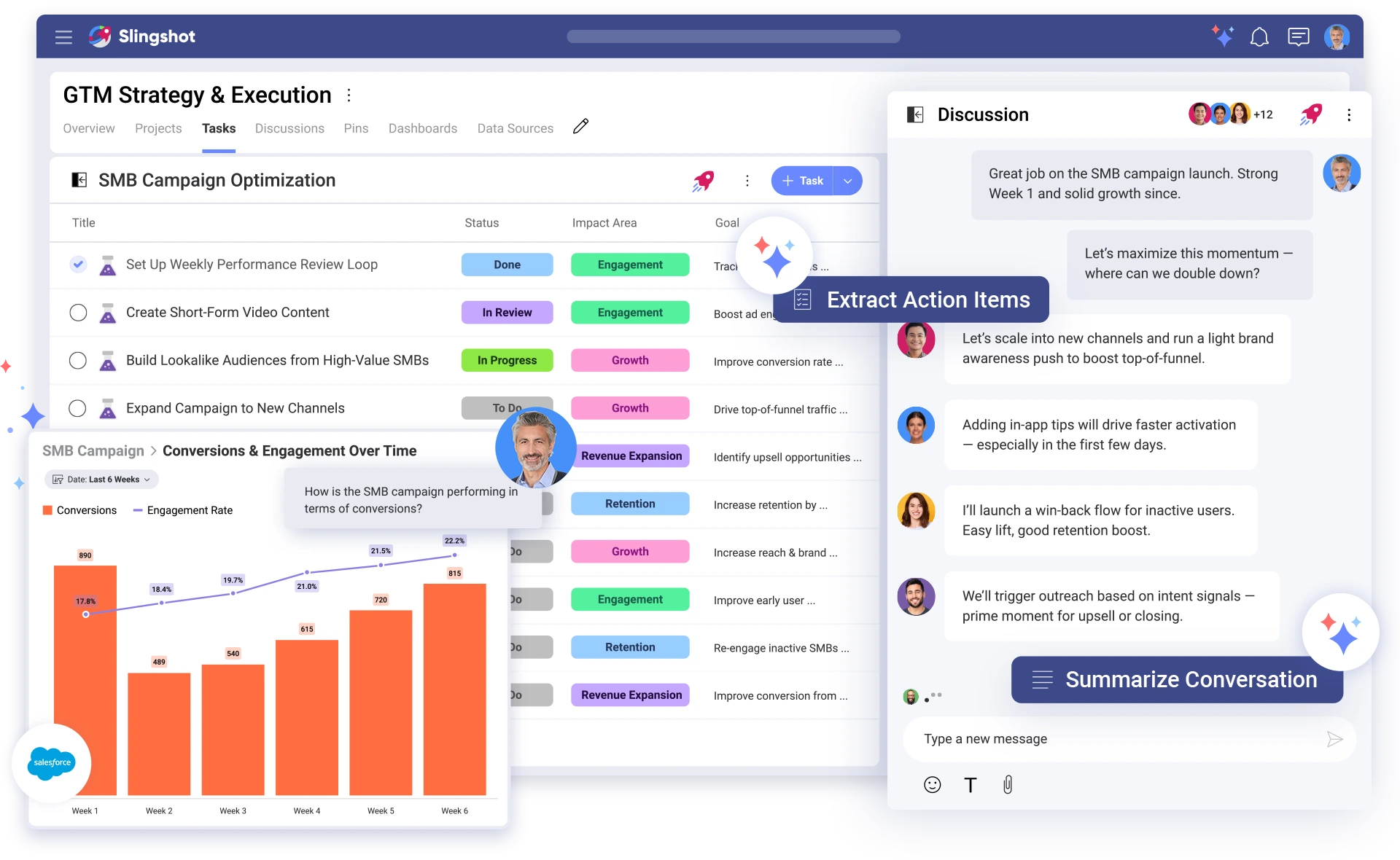
How Stephen Gould Scaled Its Capacity by 30% without Making a Single Hire
Slingshot unites data analytics and work management. Enable frictionless collaboration, real-time visibility, and AI-powered insights for connected teams and agile executions.

Unleash The Power Hidden in Your Data
Connect all your business data in one platform. Merge your sales, marketing, CRM, and other data sources into a clear, complete picture for faster, smarter decisions.
Know Everything About Your Business—Always
AI learns your business and spots opportunities. Ask any question about your data and get instant, actionable answers to improve performance.
More Than Just Work Management
Slingshot aligns teams to company-wide strategies by combining data analysis and work management. Act on insights, not assumptions, and drive measurable results ahead of your competition.

With Slingshot’s advanced analytics, transform your data into actionable insights. Connect all your data sources, visualize key metrics, and make informed decisions to drive business growth and stay competitive.
Learn More

Slingshot’s project management tools simplify complex workflows. Centralize task management, monitor progress, and improve communication. Drive successful project outcomes with a streamlined approach.
Learn More

Keep your team connected with Slingshot’s collaboration features. Manage tasks, share updates, and stay aligned on projects in real time. Boost your team’s efficiency and achieve goals together.
Learn More

Effortlessly connect and organize your content all in one place. You can connect with Google Drive, OneDrive, SharePoint, Box, and Dropbox, pin files, URLs, and project resources. Access your most important assets in context without endless searching.
Learn More

Stay ahead of your work with Slingshot’s customizable overviews, track the work across all your workspaces and projects, access key documents, and monitor performance all in one place. Know exactly when to make the best call with real-time status and productivity insights.

With Slingshot’s advanced analytics, transform your data into actionable insights. Connect all your data sources, visualize key metrics, and make informed decisions to drive business growth and stay competitive.
Learn More
Slingshot’s AI engine learns your business inside and out. Ask questions in plain language and transform your data into actionable insights that can help drive business growth.
Request a Demo
Slingshot focuses on deeper integration and real-time synchronization, making it your project control center. It allows you to easily connect your essential business tools, including Google, Microsoft, Facebook, Google Analytics, HubSpot, Salesforce CRM, and more, enhancing your workflow effortlessly.

The Leadership Wake-Up Call That Inspired A Digital Workplace
“Imagine if Asana, Slack, Tableau and maybe your cloud file storage were combined into a single platform. This is Slingshot–a place for in-person and remote teams to collaborate, use data visualizations to understand performance, set goals, share content, and communicate within the context of the projects they are working on.”





Slingshot prioritizes your data security. Your data never leaves your system. Slingshot provides end-to-end AWS encryption, user-specific keys, and single-tenant databases. You retain access permission controls, and your data stays inside your secured systems.
Learn More
Slingshot provides an all-in-one suite of features meant for enhancement in team productivity and collaboration:
All these features together integrate workflows and amplify the performance of teams.
Slingshot is designed for organizations, teams, and individuals aiming for a smarter, data-driven way to work. It’s one place for everyone, from small teams to big enterprises, to organize projects, simplify workflows, and align around what matters most. It adapts how your business works, helping you manage tasks, prioritize effectively, and drive meaningful results.
Slingshot allows decision-makers to turn raw data into insights with natively integrated business intelligence. These insights enable teams to stay connected, align, and be productive across any environment to drive productivity and collaboration forward. Slingshot’s set of tools makes sure communication is smooth, file sharing is easy, and task tracking is personalized to keep teams on target.
Slingshot fuels clarity and precision from top-to-bottom strategy to execution-aligning your cross-functional teams in real-time
Inspire success with the most powerful team-enhancing software.
